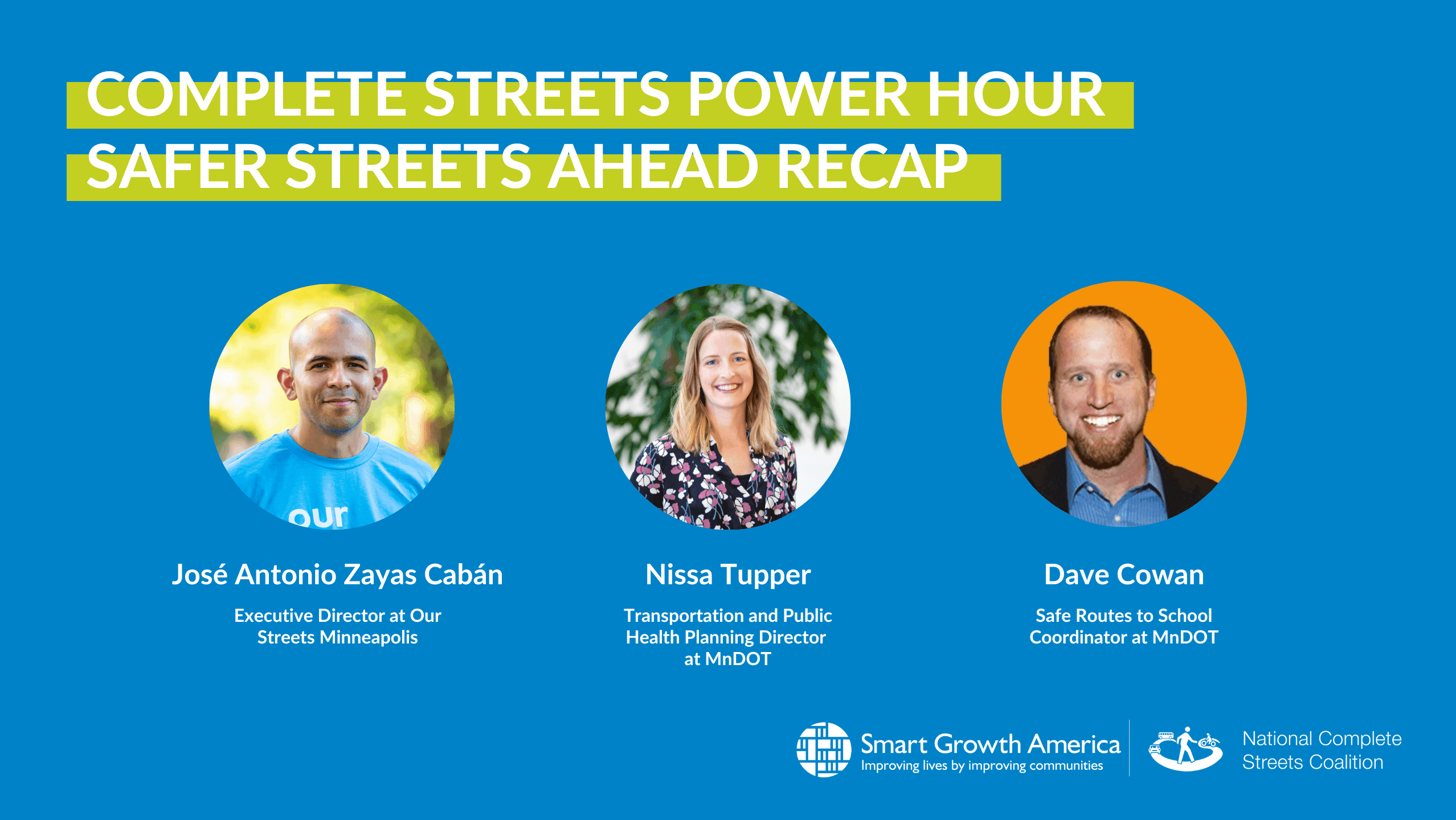
News
By Giancarlo Valdetaro, October 19, 2023
Our new webinar series brings together advocates and implementers to discuss how to advance Complete Streets in their communities. At our first Power Hour, we spoke with two implementers and one advocate from Minnesota about how they’ve gone about establishing a north star for Complete Streets in the North Star State. As it turns out, it’s all about the process.

On Tuesday, September 26th, we held our first ever Complete Streets Power Hour, talking to Dave Cowan (Safe Routes to School Coordinator, MnDOT), José Antonio Zayas Cabán (Executive Director, Our Streets Minneapolis), and Nissa Tupper (Transportation and Public Health Planning Director, MnDOT) about their experiences working to advance Complete Streets in Minnesota. With over 200 audience members listening in, sharing their experiences, and asking questions of our three panelists, we heard about how Complete Streets is not just about policies, but about processes, for both implementers and advocates.
Here are a few of our takeaways.
#1 Processes build power
From the very first question, our two panelists from MnDOT made it clear that there are two things their agency has in abundance: plans and processes. A statewide multimodal transportation plan, state transit investment plan, and Safe Routes to School Strategic Plan are just a few members of what Dave described as their “family of plans.” And Nissa described on multiple occasions the layers of internal working groups and external feedback that undergird and complement these plans.
As advocates, we know that documents are not destiny. We’ve all seen DOTs point to documents and meetings as a sign that they’re taking traffic safety seriously, only to let promises wither away on the page or in the process.
During our conversation, though, Dave and Nissa showed that while traffic safety can die by a thousand paper cuts, these same processes can breathe life back into a project. A statewide Safe Routes to School tool, case study of a Complete Streets project, or decades-long relationships for individual projects may seem innocuous or insufficient given the crisis we’re facing on our streets right now. But our MnDOT guests made clear that documents and processes are inextricably linked to a vision for Complete Streets. And without a vision that receives sustained support from leadership in elected office and state agencies, there’s no way to write the plans, stand-up the processes, and build the staff expertise that makes achieving a vision possible.
#2 Look to the past, present, and future
Every strong Complete Streets Policy starts with a clear vision and commitment. But, as our panelists explained, that vision can’t be unidirectional. Establishing a durable, achievable vision for Complete Streets requires looking at the past as much as it does the future and the present.
On that note, José shared one critical tactic for Complete Streets advocacy: showing the neighborhoods and transportation systems that were swallowed up by high-volume, high-speed roadways. We’ve seen this tactic used compellingly before, whether that’s bird’s eye visualizations or text-level explanations, and historical research from Our Streets is a rich addition to this list of tactics.
Looking backwards like this can also be a grounding source of humility and hope. Our current transportation system, epitomized by divisive infrastructure like I-94 and Olson Memorial Highway, was not the result of a single project or historical fluke. It is the outcome of federal and state programs, layers of systems that were not just established once but reauthorized and reaffirmed over and over again for decades.
This is why we talk about Complete Streets not as just a product or particular type of street, but as a process and approach. No infrastructure project is permanent. The intersections, streets, and neighborhoods we call home will change again for reasons as small as underground utility work and as significant as complete redesigns. When that change does occur, do we want to ignore history and reuse the same old systems that have scarred our communities, our environment, and our bodies? Or do we want to learn from the past and ask what policies, processes, and personnel are necessary to repair the harm that has been done and prevent it from occurring again in the future?
#3 Going beyond participation
Instead of promising citizens an occasional chance at token participation, a good Complete Streets policy promises regular, verifiable power.
Nissa described the importance of meeting people where they are and working with public health authorities especially. Dave detailed the importance of ensuring that Safe Routes to School information is available to school districts across employee turnover. These actions may seem overly bureaucratic and even innocuous, but they actually reflect an effort to restore a key pillar of any transportation system: trust.
This may be, above all else, what makes Complete Streets—in the forms of policies, plans, and processes—most useful. The vision outlined in a policy isn’t just a policy vision, but a vision for the community more broadly that needs to be owned by the community. As José stated towards the very end of our conversation, Our Streets Minneapolis “would love to enter a world where the visioning and the design and the study around projects starts with community input rather than the sort of usual where we get ideas from the department that the community responds to.”
That’s a world we can get on board with, and one that we’ll keep trying to build during our Complete Streets Power Hours. We hope you’ll join us.
Related News

© 2025 Smart Growth America. All rights reserved
Site By3Lane Marketing


















